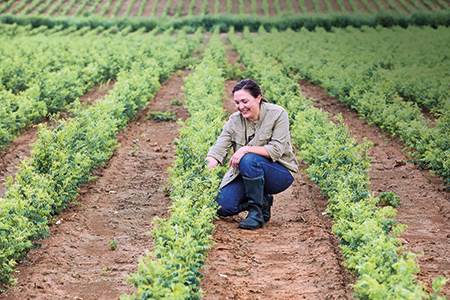“We have just this one planet, and we know externalities are ultimately paid for”

Sarah Bellos, founder and CEO of Stony Creek Colors, says the industry has yet to meet the ultimate challenge, shifting to regenerative processes and materials instead of endlessly depleting finite resources.
Despite the crises of recent years, I see true resolve and continued efforts to bring regenerative solutions to scale in our industry. Yet with energy costs and inflation rising globally, we know challenging times are far from over. We also know sustainability is a three-legged stool. How do we support the social and environmental legs when the economic leg is wobbling? I believe we must nourish the necessary evolution toward transparent and multi-stakeholder collaboration and interdisciplinary learning, even in a highly competitive environment.
This naturally carries shifting connotations depending on where you sit. Regions aiming to increase exports may prioritise access to connections, technology and funding. Areas with more advanced infrastructure might instead focus on fair enforcement of marketing claims and competitor accountability to labour and environmental standards. No matter which group we belong to, we have just this one planet, and we know externalities are ultimately “paid for” - whether we accurately value them from the outset or not.
Much of what clothing is made from today is not only derived from non-regenerative materials, but they never really go away. Example: ocean microplastic contamination from polyester. Yet some resources can be infinite. If we couple renewable practices with human ingenuity, we can produce what we need to grow our industries, without depleting endlessly.
Unfortunately, our industry has not yet met this challenge with consistency or confidence. The increased demand for organic cotton brought the resultant uncovering of severe adulteration of “certified” organic fibres. In the US this is something farmers struggle with across many industries, not just textiles. Even agricultural chemicals that have been banned in US farming make their way into our homes through food or clothing wrongly marketed as “organic” due to unenforced global standards or outright fraud.
I’ve experienced this first-hand in my 15+ years working with natural dyes. Some natural indigo continues to be sold as ‘GOTS certified’, as ‘certified organic’ or ‘natural’ when it is actually fully adulterated with synthetic, petroleum-based pigment. Far from plant-derived, this synthetic indigo is derived from aniline (a known carcinogen), sodium cyanide and formaldehyde, among other chemical inputs. Tools like certifications, Life Cycle Assessments (LCAs), and public disclosures can help to level the playing field, but only when true transparency and accountability are present.
At my company, Stony Creek Colors, we are currently using all of these tools to try to understand and communicate our impact today and where we will head as our plant-based indigo advancements reach commercial scale. Yet even in our fully vertical process, this self-study is far from perfect. Though we own the entire value chain, (from in-house agronomy and seed genetics to the farmer-grown plants and proprietary extraction processes) there is currently no way to compare our existing or future impact to that of synthetic indigo. This is mainly due to a lack of an industry standard LCA and general secrecy about the synthetic indigo used in nearly all denim today.
Our indigo crop uses the process of photosynthesis and growth to capture carbon in the plant tissue and trap aerial nitrogen in the soil, enriching it for other crops in rotation. From these crops we produce the plant-based indigo dye we sell to denim mills. What makes this an exciting opportunity for our farmers - and by extension our customers - is that our indigo process creates a climate positive chemical, one that stores more carbon than it uses while also replacing a petroleum-based chemical.
Rather than seeing our process as static, Stony Creek continues to innovate. We use data from LCAs and other third-party tools to guide our process innovations; our drive to provide truly regenerative products even led us to change our indigo plant varieties and extraction methods. The indigo seeds we now provide to our farmers were selected for their soil health properties and the benefits they provide such as rebuilding soil organic matter (a key need in fighting climate change), requiring low fertiliser levels as a legume crop, and their natural pest resistance. After moving from a semi-traditional fresh-leaf process to our proprietary dry-leaf stabilisation and extraction, a recent advancement in R&D has further refined our manufacturing to reduce water consumption – and the associated wastewater treatment – by 80% in typical factory operations.
Given one could count the number of synthetic indigo producers globally on one hand, the hidden and shadowy process should be a glaring concern to anyone focused on risk mitigation, worker health and safety, or climate. Knowing the true cost for this low priced but essential denim material should be a collaborative industry priority.
Without the knowledge of the impact of critical components to our denim supply chains, and on a shaky three-legged stool, we may pay dearly later when the bills come due. But collaboration and transparency now could allow us to properly prioritise the renewable solutions that cannot just help our industry to grow, but offer solutions for the leading economic, social and environmental issues of our time.
Sarah Bellos visits an indigo field in Tennessee.
PHOTO: Stony Creek Colors













